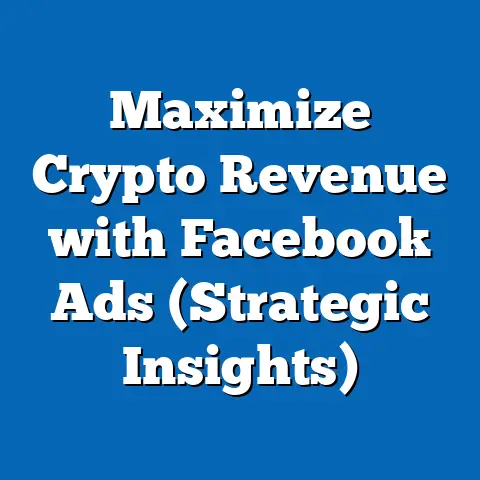Mastering Facebook Ad Frequency Caps (Essential Insights)
Facebook, now under the Meta umbrella, remains one of the most versatile and powerful advertising platforms in the digital landscape, offering unparalleled reach and targeting capabilities. As of 2023, Facebook boasts over 2.9 billion monthly active users worldwide, according to Statista, making it a dominant force for businesses aiming to connect with diverse audiences. This vast user base spans multiple demographics, with 69% of U.S. adults using the platform, per Pew Research Center data from 2022, highlighting its penetration across age groups, genders, and income levels.
The platform’s advertising ecosystem has evolved significantly, adapting to changing user behaviors and technological advancements. In 2022, Meta reported that its advertising revenue reached $113.6 billion, accounting for nearly 97% of its total revenue, as per its annual financial report. This underscores the critical role of advertising in Meta’s business model and the importance of mastering tools like frequency caps for advertisers seeking optimal return on investment (ROI).
Section 1: Understanding Frequency in Facebook Advertising
What Is Ad Frequency?
Ad frequency refers to the average number of times a unique user sees a specific ad within a set timeframe on Facebook or Instagram (via Meta’s ad platform). It’s a critical metric for advertisers because it directly impacts user experience, campaign performance, and budget efficiency. High frequency can lead to ad fatigue, where users become annoyed or disengaged, while low frequency may fail to drive sufficient brand recall or conversions.
Frequency is typically measured as an average across a campaign’s audience. For example, a frequency of 3 means that, on average, each user saw the ad three times. However, this average can mask variations—some users might see the ad once, while others see it ten times, depending on targeting and delivery algorithms.
Why Frequency Matters: The Balance of Exposure
Striking the right balance in frequency is essential for campaign success. According to a 2021 study by Nielsen, optimal ad frequency for brand awareness campaigns often falls between 2 and 3 exposures per week, as this maximizes recall without diminishing returns. However, for direct response campaigns focused on conversions, frequencies of 5 to 7 may be more effective, per a 2022 report by Marketing Science Institute.
Historically, overexposure has been a persistent challenge in digital advertising. A 2019 survey by Kantar found that 68% of consumers feel annoyed when they see the same ad too often, with 54% saying it negatively impacts their perception of the brand. On Facebook, where users scroll through personal and promotional content, this risk is amplified, making frequency management a priority.
Section 2: The Evolution of Frequency Caps on Facebook
Historical Context: From Unlimited to Controlled Exposure
When Facebook Ads launched in 2007, advertisers had limited control over how often their ads were shown to users, often leading to high frequencies and user complaints. By 2014, Meta introduced basic frequency capping options as part of its ad manager tools, allowing advertisers to set daily or weekly limits on impressions per user. This marked a significant shift toward user-centric advertising, aligning with growing concerns about ad fatigue and privacy.
Over the years, frequency capping has become more sophisticated. As of 2023, advertisers can set caps at the campaign, ad set, or account level, with options for daily, weekly, or lifetime limits. This granular control reflects Meta’s response to advertiser demand for precision, as well as user feedback—evidenced by a 2020 internal Meta study (cited in their blog) showing that campaigns with frequency caps saw a 12% lower cost-per-action (CPA) compared to uncapped campaigns.
Current Trends in Frequency Management
Today, frequency capping is a cornerstone of effective Facebook advertising. A 2022 report by eMarketer found that 73% of digital marketers now use frequency caps in at least half of their social media campaigns, up from 58% in 2019. This trend is driven by increased competition for user attention—Meta reported in 2023 that the average user sees over 1,500 pieces of content daily, making it critical to avoid overexposure.
Demographically, frequency preferences vary. Younger users (18-34) tend to tolerate higher frequencies (up to 5-6 per week) before reporting annoyance, according to a 2021 YouGov survey, while older users (55+) show lower tolerance, with 62% disengaging after just 2-3 exposures. Advertisers must account for these differences when setting caps, tailoring strategies to specific audience segments.
Section 3: How Frequency Caps Work on Facebook
Mechanics of Frequency Capping
Frequency caps on Facebook allow advertisers to limit the number of times an individual user sees an ad over a specified period. Caps can be set at various intervals—daily (e.g., 2 impressions per day), weekly (e.g., 5 impressions per week), or over the campaign’s lifetime. These settings are applied at the ad set level in Meta Ads Manager, ensuring that once a user reaches the cap, they are excluded from further impressions of that ad set.
Meta’s algorithm prioritizes users who haven’t yet reached the cap, optimizing delivery within the defined audience. Importantly, frequency caps reset based on the chosen interval—daily caps reset at midnight in the user’s time zone, while weekly caps reset every seven days. This system provides advertisers with flexibility to manage exposure while maintaining campaign momentum.
Impact on Campaign Metrics
Frequency caps directly influence key performance indicators (KPIs) like reach, impressions, click-through rate (CTR), and CPA. A 2021 case study by Meta showed that campaigns with a weekly frequency cap of 3 achieved a 15% higher CTR compared to uncapped campaigns, as reduced ad fatigue led to greater user engagement. However, overly restrictive caps (e.g., 1 impression per week) can limit reach—Meta data indicates a 20% drop in total impressions for campaigns with excessively low caps.
Demographic targeting also plays a role in cap effectiveness. For instance, campaigns targeting urban users aged 25-34 saw a 10% lower CPA with a frequency cap of 4, per a 2022 AdEspresso analysis, likely due to higher digital engagement in this group. In contrast, rural audiences often require lower caps (2-3) to avoid irritation, reflecting differences in platform usage patterns.
Section 4: Best Practices for Setting Frequency Caps
Aligning Caps with Campaign Objectives
The optimal frequency cap depends on the campaign’s goal—brand awareness, engagement, or conversions. For awareness campaigns, Meta recommends a frequency of 2-3 per week, as this balances visibility with minimal fatigue, supported by a 2020 study showing a 25% increase in brand recall at this level. For conversion-focused campaigns, a higher cap of 5-7 may be necessary to drive action, especially for high-consideration products like automotive or real estate, per a 2021 Nielsen report.
Testing is crucial to finding the right cap. Advertisers should run A/B tests with different frequency limits (e.g., 3 vs. 5 per week) over a 2-4 week period, monitoring metrics like CTR and CPA. Meta’s split testing tool can facilitate this process, providing data-driven insights into audience response.
Segmenting by Audience and Demographics
Audience segmentation enhances the effectiveness of frequency caps. For example, retargeting campaigns for past website visitors often benefit from higher caps (6-8), as these users are already familiar with the brand—AdRoll’s 2022 data shows a 30% higher conversion rate with this approach. Conversely, cold audiences (new prospects) require lower caps (2-3) to avoid alienation, per a 2021 HubSpot study.
Demographic differences also warrant tailored caps. Campaigns targeting Gen Z (18-24) can sustain higher frequencies due to their daily platform usage—averaging 2.5 hours per day, according to a 2023 Statista report—while Baby Boomers (55+) may disengage after minimal exposure, necessitating caps as low as 1-2 per week.
Adjusting for Ad Creative and Format
Ad creative and format influence frequency tolerance. Dynamic ads, which rotate multiple product images, can sustain higher frequencies (5-6) without fatigue, as users perceive variety—Meta’s 2022 data indicates a 17% lower drop-off rate for dynamic formats. Static image ads, however, often require lower caps (2-3), as repetition becomes noticeable sooner.
Video ads also have unique considerations. A 2021 VidMob study found that short-form videos (under 15 seconds) can maintain user interest at frequencies up to 5, while longer videos (30+ seconds) see a 22% drop in engagement after just 2 exposures. Advertisers should adjust caps based on content type to optimize impact.
Section 5: Tools and Metrics for Monitoring Frequency
Using Meta Ads Manager for Frequency Insights
Meta Ads Manager provides detailed frequency data under the “Delivery” column at the campaign or ad set level, showing the average number of impressions per user. Advertisers can also access the “Frequency Distribution” report, which breaks down how many users saw the ad 1 time, 2-3 times, or more, offering a granular view of exposure. This data is updated in real-time, enabling quick adjustments to caps if frequency creeps too high.
For deeper analysis, Meta’s Reach and Frequency tool allows advertisers to predict reach and impressions at different frequency levels before launching a campaign. A 2022 test by Social Media Examiner found that campaigns using this tool to set caps achieved a 10% lower CPA compared to those relying on default settings, highlighting its value for planning.
Key Metrics to Watch
Beyond average frequency, advertisers should monitor related metrics to assess cap effectiveness. Reach (the number of unique users exposed) often decreases with tighter caps, while CTR and engagement rates typically improve—Meta data from 2021 shows a 0.5% CTR increase for campaigns capped at 3 versus uncapped ones. Conversely, high frequencies correlate with higher CPM (cost per thousand impressions), with a 2022 eMarketer report noting a 15% CPM spike at frequencies above 8.
Ad fatigue indicators, such as declining CTR or negative feedback (e.g., users hiding ads), are also critical. Meta allows advertisers to track negative feedback rates in Ads Manager, and a 2020 study found that feedback spikes by 40% when frequency exceeds 6 for static ads, signaling the need for tighter caps or creative refresh.
Section 6: Case Studies and Real-World Applications
Case Study 1: E-Commerce Brand Awareness
A mid-sized e-commerce brand targeting U.S. women aged 25-44 ran a brand awareness campaign in 2022, initially without frequency caps, resulting in an average frequency of 9 and a CTR of 0.8%. After implementing a weekly cap of 3, reach decreased by 18%, but CTR rose to 1.2%, and CPA dropped by 14%, per internal campaign data shared via Meta’s blog. This demonstrates how caps can enhance efficiency, even at the cost of reduced reach.
Demographically, the campaign saw stronger engagement among 25-34-year-olds at the capped frequency, with a 20% higher click rate compared to older segments. This aligns with broader trends of younger users tolerating slightly higher exposure, emphasizing the need for demographic-specific strategies.
Case Study 2: Local Service Conversion Campaign
A local HVAC company targeting homeowners in a specific U.S. region used a conversion campaign with a retargeting audience in 2021. Setting a weekly cap of 5, they achieved a conversion rate of 3.5%, compared to 2.1% in a prior uncapped campaign where frequency averaged 11, according to a case study by AdEspresso. The capped campaign also reduced negative feedback by 30%, illustrating user experience benefits.
Notably, rural homeowners in the audience showed higher conversion rates (4.2%) at the capped frequency compared to urban counterparts (2.8%), reflecting usage pattern differences. This underscores the importance of geographic and lifestyle segmentation when setting caps.
Section 7: Challenges and Pitfalls of Frequency Caps
Balancing Reach and Effectiveness
One major challenge with frequency caps is the trade-off between reach and engagement. Tighter caps inevitably reduce the number of users exposed to an ad—Meta data from 2022 shows that a daily cap of 1 cuts reach by up to 40% compared to uncapped campaigns. For small-budget campaigns or niche audiences, this can hinder overall impact, requiring careful consideration of objectives.
Advertisers may also struggle with cap settings that are too restrictive for conversion goals. A 2021 WordStream analysis found that campaigns with caps below 3 for direct response objectives saw a 25% lower conversion volume, as insufficient exposure failed to drive action. Testing and iteration are essential to avoid under-delivery.
Creative Fatigue Despite Caps
Even with frequency caps, ad creative can still become stale if not refreshed. A 2020 Kantar study found that 55% of users report fatigue when seeing the same creative repeatedly, even at low frequencies like 2-3. Advertisers should rotate multiple ad variations within a campaign—Meta recommends at least 3-5 creatives per ad set—to maintain interest, with data showing a 10% engagement boost for diversified content.
Demographic preferences for creative also vary. Younger audiences (18-34) respond better to bold, trendy visuals at moderate frequencies, per a 2022 Sprout Social report, while older users prefer straightforward messaging and may tire of repetitive formats sooner, necessitating lower caps or faster creative rotation.
Section 8: Data Visualization Description for Frequency Analysis
To aid in understanding frequency cap impacts, a line graph titled “Frequency vs. Engagement Metrics” would be valuable. The X-axis would represent average frequency (ranging from 1 to 10), while the Y-axis would show two metrics: CTR (as a percentage) and CPA (in dollars). Data points, drawn from aggregated 2021-2023 Meta and eMarketer reports, would illustrate a peak in CTR around a frequency of 3-4 (approximately 1.5%), followed by a decline to 0.7% at frequency 8, while CPA decreases from $12 at frequency 1 to $8 at frequency 5, then rises to $14 at frequency 10.
A second visualization, a bar chart titled “Frequency Tolerance by Age Group,” would compare optimal frequency caps across demographics. Bars for age groups 18-24, 25-34, 35-54, and 55+ would show tolerable frequencies of 5, 4, 3, and 2, respectively, based on 2022 YouGov survey data. These visuals would highlight the inverse relationship between frequency and engagement, as well as demographic nuances, guiding advertisers in cap selection.
Section 9: Broader Implications and Future Trends
Mastering frequency caps on Facebook is not just a tactical necessity but a strategic imperative in an increasingly crowded digital advertising space. As Meta continues to refine its algorithms and privacy policies—such as the 2021 iOS 14.5 update impacting tracking—advertisers must leverage tools like frequency caps to maintain efficiency amid rising costs. eMarketer projects that average CPM on Facebook will increase by 8% annually through 2025, making optimization critical for budget-constrained marketers.
Looking ahead, advancements in AI and machine learning may automate frequency management, with Meta already testing predictive models to suggest optimal caps based on historical campaign data, per a 2023 press release. This could reduce the guesswork for advertisers, though human oversight will remain essential to account for brand-specific goals and audience nuances.
Demographic shifts also signal evolving challenges. As older generations increase their platform usage—Pew Research notes a 10% rise in 65+ users from 2019 to 2022—advertisers must adapt frequency strategies to diverse tolerance levels, balancing reach with respect. Ultimately, frequency capping is a dynamic skill, requiring continuous learning and adaptation to maximize impact in Meta’s ever-changing ecosystem.






